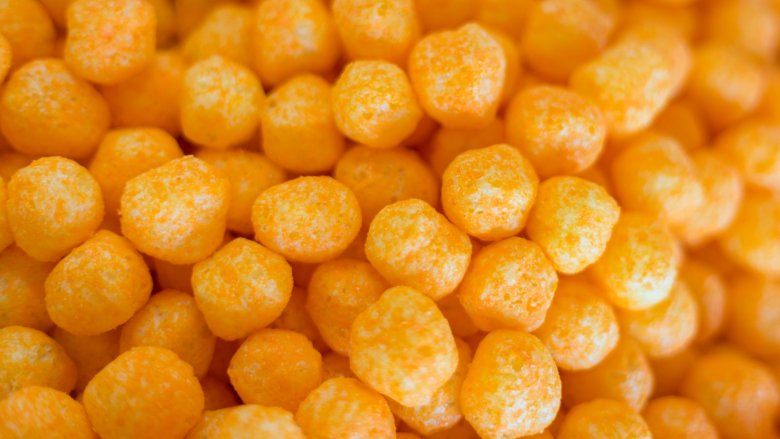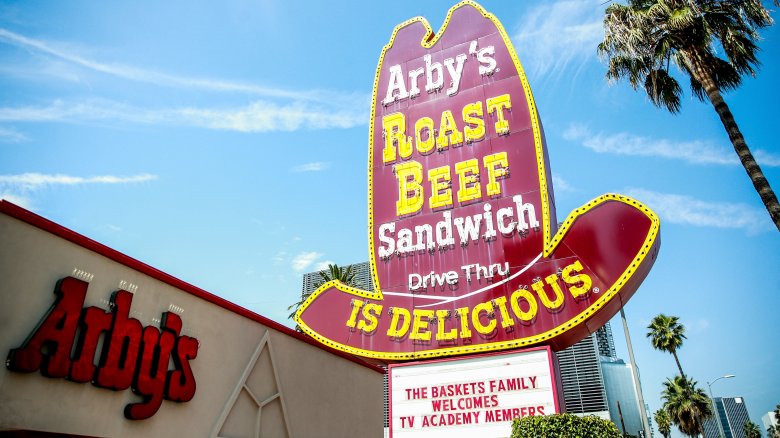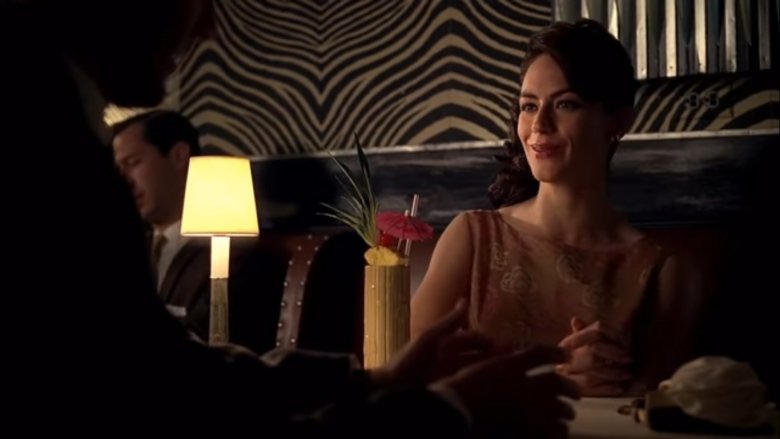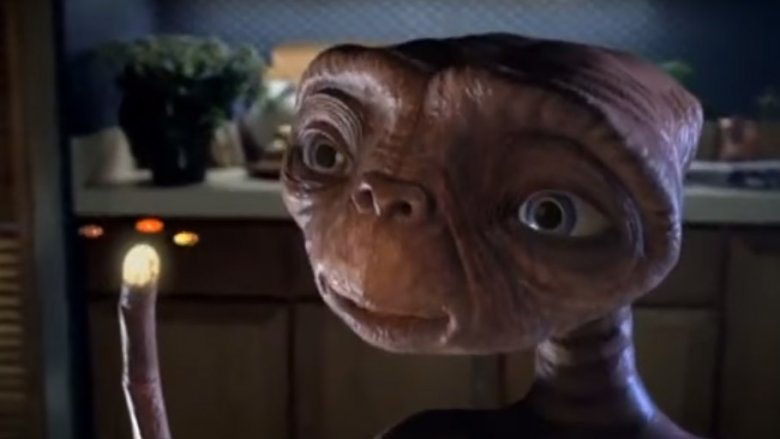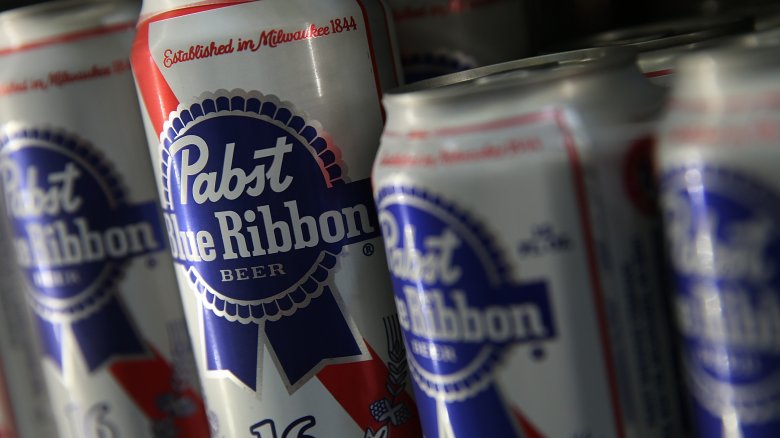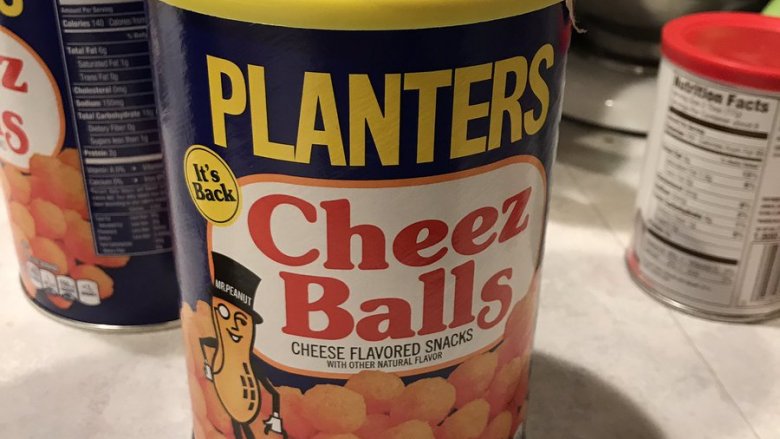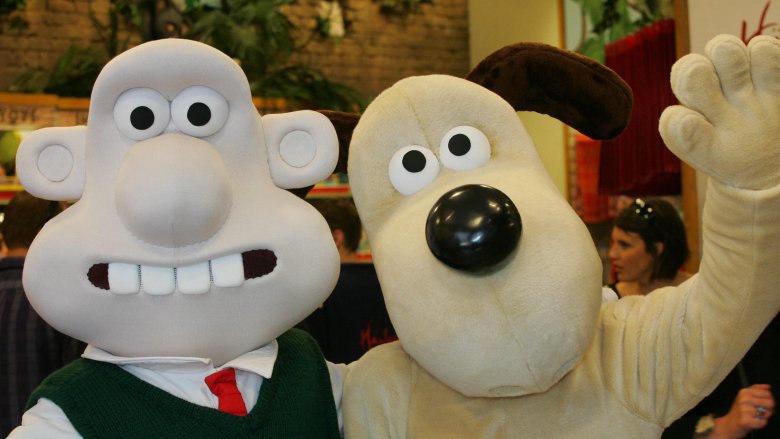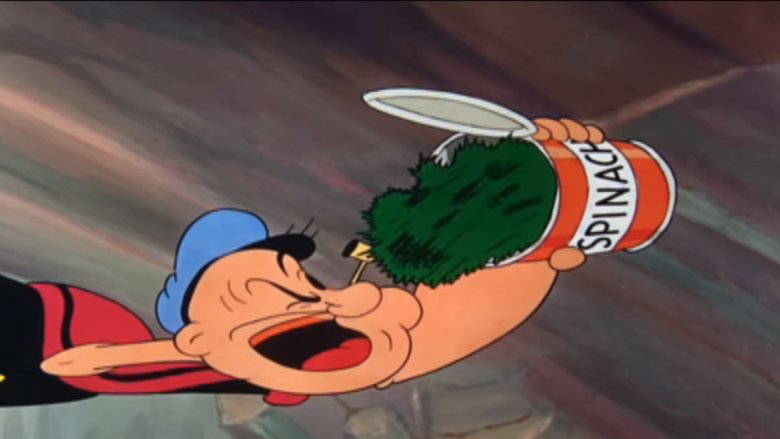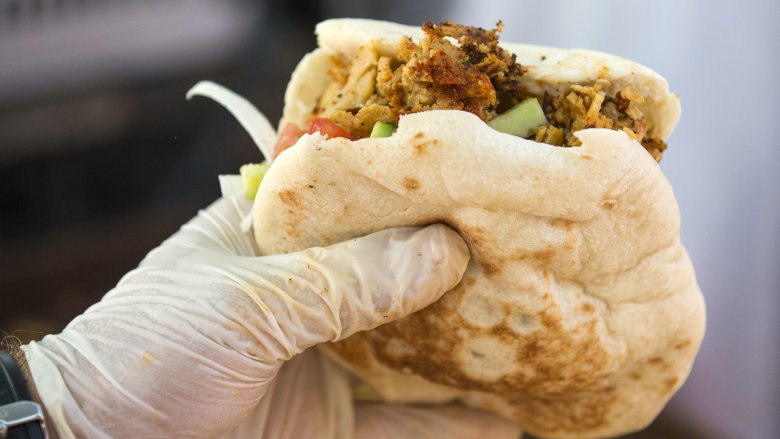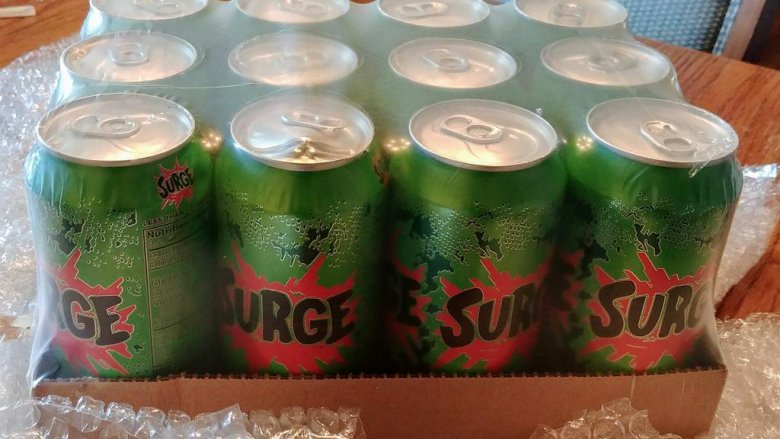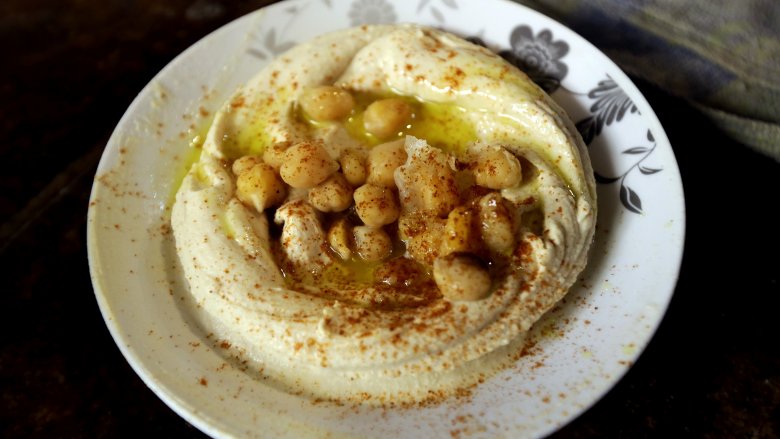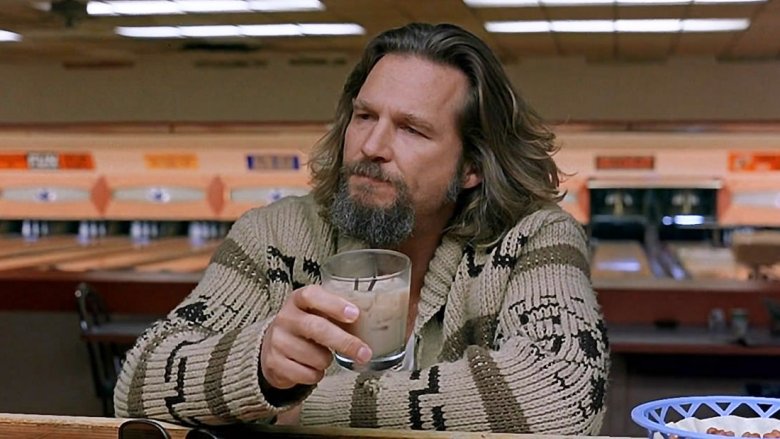Bizarre Moments That Saved These Foods From Extinction
It can be difficult to predict food trends, and while some foods have been around so long they're about as exciting as tap water, others are a bit more left field and can come and go in the blink of an eye. Certain foods probably won't ever make a comeback — we're looking at you, candy cigarettes — but others have been fortunate enough to get a reputation boost, often times in the most unexpected of ways.
Sometimes it's nostalgia that brings these foods back into the public eye, other times it's a popular movie or clever marketing tactic that reminds the public of their existence. Let's take a look at some unusual stories that resulted in sales bumps, and in some cases, brought food and drink products back from the dead for another shot at mainstream success. Kick back and grab yourself a bowl of Cheez Balls or a tiki cocktail, as we investigate these bizarre food comeback stories.
A Grammys tweet helped save Arby's sales
The fast food racket is brutal, and there's no guarantee that a chain will still be asking customers if they'd "like fries with that?" into the next decade. Arby's has been around since 1964, but by 2010, they were struggling to stay above water. Restaurant analysts said they were among the worst-performing chains in the country. Clearly it would take more than a new roast beef sandwich to save them. In fact, J.P. Morgan analyst John Ivankoe noted in 2010, "Arby's performance is amongst the worst in modern restaurant history."
Oddly enough, it was a joke on Twitter that really pushed Arby's back into the spotlight and gave people a reason to acknowledge the fast food restaurant's existence. When rapper/producer Pharrell Williams showed up to the 2014 Grammy Awards wearing a goofy hat that looked suspiciously like the roast beef chain's logo, Arby's Twitter account was quick to call him out on it. "Hey Pharrell, can we have our hat back?" read the viral tweet that quickly landed Arby's 6,000 new followers.
Perhaps it was coincidence or just sheer luck, but around the same time as that tweet Jon Stewart was using Arby's as a punchline in jokes on The Daily Show. Rather than go on the defensive, Arby's embraced Stewart's humorous jabs for two years and ultimately boosted their sales in the process.
Mad Men played a part in the return of the tiki cocktail
Rum with pineapple juice and a pink umbrella all served up in a funky glass that looks like an ancient Polynesian god — what's not to love? Americans seem to have a bit of a love-hate relationship with tiki drinks. They're fun for a few years, then drinking culture decides, "nope, they're tacky," and shoves those tiki glasses and paper umbrellas in a cardboard box under the bar to forget about them. Tiki drinks and the bars dedicated to them were all the rage in the mid-20th century, but by the 1980s, tiki anything was considered a lame relic of the past.
While tiki drinking culture was slowly making a comeback in England, a certain show in the United States helped reintroduce tiki to the masses in the late 2000s. Much the same way AMC's Mad Men brought back skinny ties and mid-century modern furniture, it helped reintroduce Americans to the tiki with Don Draper's date Rachel Menken sipping on a mai tai. "I think that show was a big cultural touchstone and got people interested in things they'd never heard of," tiki historian Jeff "Beach Bum" Berry told Eater.
In the years since Mad Men was on TV, tiki bars have been popping up in cities such as San Francisco, Houston, and places not even close to the ocean like Grand Rapids, Michigan. Thanks, Mr. Draper, America needed a reminder about the awesomeness of tiki.
E.T. helped boost Reese's Pieces
Can a candy be good enough to travel across the universe for? Well, in the case of Reese's Pieces, that seems to be the case — at least in the movies. Product placement can be incredibly powerful in movies and TV and one of the most successful examples of this is when the alien in E.T. was seen gobbling up Reese's Pieces. Before the movie was released, the candy's sales were sagging, but they skyrocketed after E.T. came out. Before we expand on that though, we need to look at the candy that missed out on the blockbuster promotion.
During production of the movie, Amblin Productions went to Mars, Inc. about a possible tie-in between M&Ms and the film. Mars said "thanks, but no thanks." So why would a candy giant pass on having their product featured in a movie by Steven Spielberg? Well, the possible reasons range from the company thinking the movie would be a flop to not wanting its product associated with a space alien shacking up with a human family.
It was an incredibly dumb move on Mars' part, because then-Hershey's vice-president of new-business development, Jack Dowd, jumped at the chance and Hershey's agreed to spend $1 million over a six-week period promoting E.T.
The movie went on to be a huge hit of course, and within weeks, sales of Reese's Pieces were out of this world and rose 85 percent.
PBR has bike messengers to thank for saving it
These days, lovers of Pabst Blue Ribbon can show their fandom with everything from socks to skis. In the late 1990s, however, this beer brand was headed for complete irrelevance after over 150 years of business. So how did PBR go from a 90 percent sales drop between 1978 and 2001 to a total rebirth? Hipster bike messengers, that's how.
More specifically, the beer brand hired a brand manager who found a way to put the beer into nearly every dive bar in America and make it the unofficial brew of choice for American hipster culture.
Neal Stewart was just 27 when he was tasked with bringing PBR's 50 to 60s drinking base down by about 30 years. He'd heard that sales of the beer were doing well in Portland, Oregon and visited only to discover that it was popular at bars frequented by the city's bike messengers. Stewart then began to build relationships with bike messenger groups in other cities. No million dollar ad campaigns needed either, just some free swag. "If I saw someone drinking Pabst, I'd slip them a keychain or a hat, and they'd get excited and tell other people, 'Hey, the Pabst guy is here.'" Stewart said.
Pabst slowly began sponsoring not multi-million dollar sporting events, but small things like adult kickball tournaments or a skateboard video screening. From there, PBR began to pick up favor with hipsters in cities across the nation and by 2003, sales were on the upswing.
Facebook revived Planters Cheez Balls
Social media is a powerful tool, and kids of the 1980s have Facebook to thank for bringing back a snack from the past. Cheez Balls, the snack that inevitably left fans with orange-dusted fingers, were rather popular in the '80s and '90s. However, they eventually faded in popularity and not enough people were picking up those cheesy cans for Planters to continue making them. The company finally decided to pull the plug for good and removed Cheez Balls in 2006.
Not surprisingly, fans of the snack weren't too pleased with the loss of their favorite junk food and an online movement soon began to bring them back. Facebook groups demanding their return — along with a plea for the return of Cheez Curls — petitioned Planters for over a decade to bring back the cheese. Finally, after 12 years, Planters announced the snacks' return with a roll-out of the snacks to select stores, as well as Amazon and Walmart. Since their initial 2018 roll-out, Cheez Balls have made their way back to some national grocery stores as well. It just goes to show that if you bug a company long enough on social media, they just might deliver on that request.
Wallace and Gromit saved Wensleydale cheese
While we're on the subject of cheese (or is it cheez?), a certain British stop-motion animation duo played a role in helping to save a struggling cheese company with its roots dating all the way back to the 11th century. The Wensleydale Creamery in North Yorkshire, England was once on the verge of bankruptcy — for the fourth time — but got a major boost because of the Wallace and Gromit movie A Close Shave.
Prior to the 1995 movie, the Wensleydale Creamery was struggling and its supply of local dairy farmers were close to leaving for another cheese company. Things began to turnaround though thanks to a particular scene in the film where the romantic interest of Wallace turns down his invitation for some cheese and he responds, "Not even Wensleydale?" It was an incredibly small product plug, but proved to be worth millions in the long run.
Sales soon surged and the Wensleydale Creamery eventually made enough money to buy the competition. "Wallace & Gromit have probably boosted company sales by £63 million in the last 15 years," David Hartley, the creamery's managing director said.
Popeye helped save the spinach industry
Parents of picky eaters have been telling their kids to eat their spinach so they can grow up to be big and strong for decades — and it's all because of a cartoon sailor. That cartoon sailor, of course, is Popeye, and he's been using spinach as his secret nutritional weapon since the 1930s. While Popeye may not exactly be the hippest cartoon with today's children, his impact in the '30s was pretty significant on the spinach industry as a whole.
The United States was grappling with the Great Depression in the 1930s and spinach sales were suffering. The U.S. government was looking for a way to help boost sales of the crop and turned to the comic strip to help. In Popeye's early comics the source of his super strength wasn't revealed, but then spinach was worked into the storyline as his secret strength weapon and it was a major game-changer. Spinach sales jumped by about 30 percent and soon kids were clamoring for a chance to try the veggie that made Popeye so strong.
There's also a pretty good reason Popeye got his spinach from a can. The U.S. government wanted Americans to know that canned goods were ideal for stocking up on food during hard times and Popeye's regular consumption of canned spinach helped drive this point home.
The Avengers bumped up shawarma sales
The Avengers might get more fanfare when they save the universe, but they've also proven they can do wonders for the culinary world as well. The favorite foods of Tony Stark (aka Iron Man) have been well-documented, and among things like Los Angeles' Randy's Donuts, Iron Man has a love of the Middle-Eastern street food shawarma.
In the first Avengers movie there's a scene where post-battling the Chitauri, Iron Man suggests a shawarma restaurant on Sixth Avenue in Manhattan. A scene in the end credits of The Avengers with the superheroes quietly enjoying their meal in the empty restaurant was all it took to drive the point home and have Marvel fans craving the roasted meat and pita sandwich.
While shawarma may not have been on the verge of fading into extinction at the time, The Avengers definitely boosted sales and introduced the dish to people who had never heard of it before.
"It had an impact on the first-timers on the shawarma if they'd never tried it before," Fares Zeideia, the owner of a food cart in Astoria said. "I had my steady customers before that, but a lot of people came out of nowhere. The first four or five weeks [after the movie came out], forget about it, I was running out of shawarma by 3 or 4 o'clock."
The power of '90s nostalgia and the internet brought Surge back from the dead
Things of the past have a weird way of coming back into favor after they've been gone a few decades. One of the best examples of this is 1990s Coca-Cola-made soft drink Surge. It was the perfect citrus-flavored soft drink for carrying around in the back pocket of your JNCO jeans and whipping out a can whenever you needed to "feed the rush." Then sales started to slip and Surge went the way of the Discman, disappearing off the market in the early 2000s.
Surge is back now and it's all thanks to a healthy dose of '90s nostalgia that found a home on the internet. Similar to our example with Cheez Balls, a Facebook page called Surge Movement was formed and it began to pick up steam, eventually catching the attention of Coke.
In September of 2014, it was announced that Surge would be returning to "feed the rush" via 12-packs of the soda for sale on Amazon. Sales of the drink were a hit and in 2018 Coke struck up a deal to offer Surge at Burger King locations with a freestyle soda fountain. There's no telling if Surge will hang around for good, but its return is certainly a soda success story.
Adam Sandler helped introduce hummus to chickpea-deprived Americans
It's not easy to be in the hummus business in the United States. The largest seller of hummus in the U.S., Sabra, claims that some 80 million Americans don't even know what it is. While there still may be a large portion of folks around the U.S. who aren't dipping their pita chips in the chickpea-based dip, a significant portion are and they have an Adam Sandler movie to thank for it. The 2008 film You Don't Mess With The Zohan featured Sandler's character using hummus for everything from styling his hair to putting out fires. Naturally, people were curious about the food.
While Zohan may not have been a hit with film critics, it was a hit with the hummus industry. The movie introduced the Middle Eastern dish to people who had never even heard of it, let alone tried the dip. Dave Clements, a Salt Lake City retiree, told Fast Company that after seeing the movie he had to try it and see what the big deal was. "I thought, 'This is good. I see why people eat it,'" Clements said.
Clements wasn't alone either. Over the course of 21 months, hummus consumption grew by 35 percent and resulted in sales of $300 million.
The Dude helped make the White Russian cool again
Dairy isn't exactly a popular ingredient in most cocktails. So it should really come as no surprise that the White Russian has had a bit of an uphill battle in maintaining its place on bar menus. Made with vodka, coffee liqueur, and cream, the White Russian had its moment in the 1960s and '70s, but by the early '90s it had lost any popularity it ever had. "When I first encountered it in the 1970s, the White Russian was something real alcoholics drank, or beginners," Esquire drink correspondent David Wondrich, told The New York Times. That would all change because of a long-haired, sunglasses-clad slacker.
The drink got a major boost courtesy of the Dude in the Coen Brothers 1998 movie The Big Lebowski. Jeff Bridges throws back nine White Russians over the course of the film and fans have been ordering them ever since. While it may not be as popular as a margarita, the White Russian is king anytime a Big Lebowski fan is nearby. For example, at one Lebowski Fest in Louisville, Kentucky, milk had sold out within a one-mile radius of the bowling alley hosting the event. The resurgence of this dairy concoction has even resulted in variations of the drink such as the Skinny Russian and the White Trash Russian (that's just a mixture of Yoo-Hoo and vodka for the curious).
